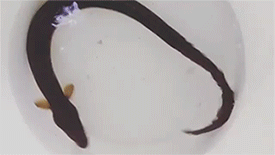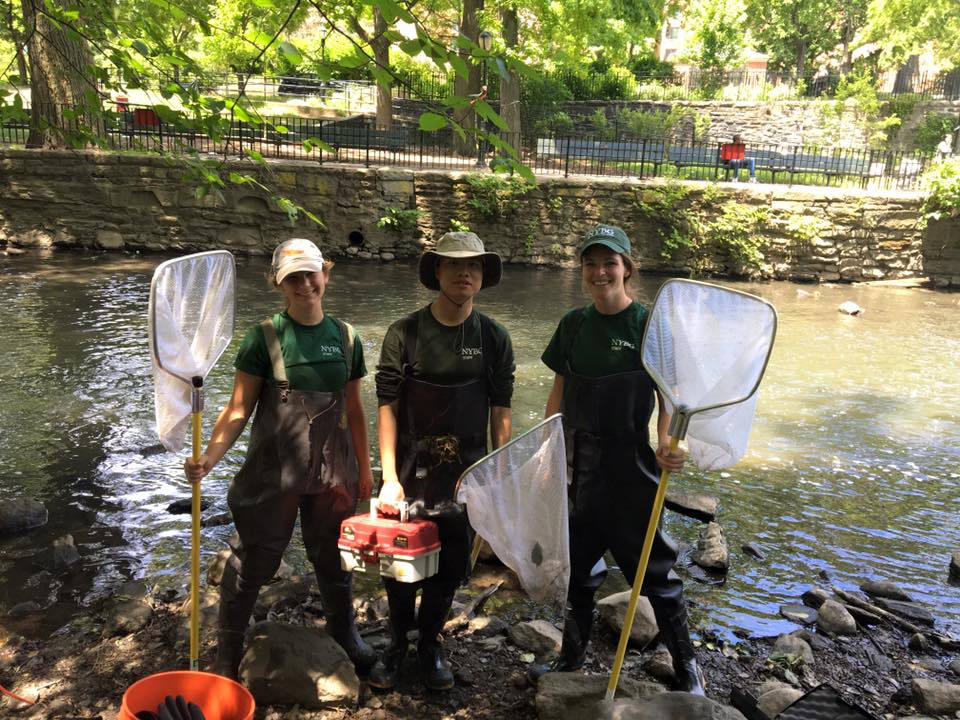Wanted: American Eel
Posted in Learning Experiences on November 2, 2016 by Laura Booth
Laura Booth is a Forest intern with The New York Botanical Garden.

A quicksilver flash diverts your eye from the Bronx River’s frothy flow over the 182nd St. dam at River Park. Was it just the remnants of a potato chip bag slithering downstream?
Look again, and quick! If you’re lucky, you could glimpse an American eel, Anguilla rostrata.
Against unfavorable odds, the American eel has persisted in the urban waterways of New York since the city’s inception—surviving years of industrial pollution, raw sewage dumping, and runoff. In recent years, their populations have entered a precipitous decline, driven in part by long-term effects of the damming of freshwater rivers and streams, which they require as habitat.
What makes this strange and wonderful species—its finely-scaled body coated in a mucous layer that is truly “slippery as an eel”—important?
American eel are catadramous, meaning that unlike most other species, they spend the majority of their time in freshwater rivers, journeying to the sea only to breed. They lead long lives, with some individuals surviving 20 years. In this time, chemicals can accumulate in their tissues, offering scientists the opportunity to study what compounds, including toxins, may be present in the water. Eel also play a vital role both as predators and prey in freshwater river systems.
Of course, to gather information about individuals and populations of eels, scientists must go out in the field and trap them.
On the morning of June 13, the other forest interns and I joined Jake LaBelle of the Wildlife Conservation Society and his team of surveyors in a parking lot at the Bronx Zoo. As we organized waders, nets, buckets, and the all-important electrofishing backpack, a pair of red-tailed hawks spiraled upwards on a thermal, disappearing over the tree line. It felt like an auspicious day for seeing—and learning about—wildlife.

We began our survey at the 182nd St. dam in River Park, the farthest downstream of the three sites Jake wanted to complete. To fulfill a standard electrofishing protocol, one member of the team wears a backpack containing a large battery connected to a long wand with a metal ring at the end, which he or she moves back and forth through the water. In combination, this equipment acts to deliver a minor electric current to the river, momentarily stunning eels and other fish so that they can quickly be scooped up by flanking team members.
Eel movements are virtually halted by dams unless people intervene to help them. Aid typically comes in the form of mechanical solutions, such as eel passes, which allow eel to climb up and over dams. Thanks to a partnership with the NYC Parks Department, an eel pass was installed at 182nd St in 2015. Still, the dam stops a large fraction of young eels on their trip upriver. For this reason, we expected to see substantially more eels at this southernmost site than at our other two sites farther upriver, at the Bronx Zoo and in The New York Botanical Garden.
Indeed, this proved to be the case: whereas we caught about 60 eels at River Park, we caught 12 at the Bronx Zoo site, and only 3 at the Botanical Garden site, which is the farthest upriver of the sites we sampled and requires eels to pass over multiple dams to reach it.
Over the course of the day, several members of our team remained onshore to take measurements—such as body length—from the eels we caught. They also inserted small tags under the skin of sufficiently large individuals. These tags allow scientists to know when they have recaptured a single eel, which can provide them with data on individual survival over time, and movements of eels between segments of the river.
Along our journey against the current, we spotted evidence of the Bronx River’s long recovery: a black-crowned night heron perched in the trees at River Park, yellow and white perch, crayfish, pumpkinseed sunfish, striped bass, and more. Perhaps the most satisfying triumph of all was Jake’s sighting of a single, silvery alewife, a symbol of optimism in conservationists’ long struggle to improve the health of this herring’s population, which remains poor within the Bronx River.
Although we won’t know precisely what shape eel populations are in until Jake and his team analyze their data, the wealth of biodiversity we observed on the river is evidence that urban systems need not divide humans from nature. Rather, cities can be sites of community learning and engagement around the many rich ecosystems of New York City—if we steward them thoughtfully.

